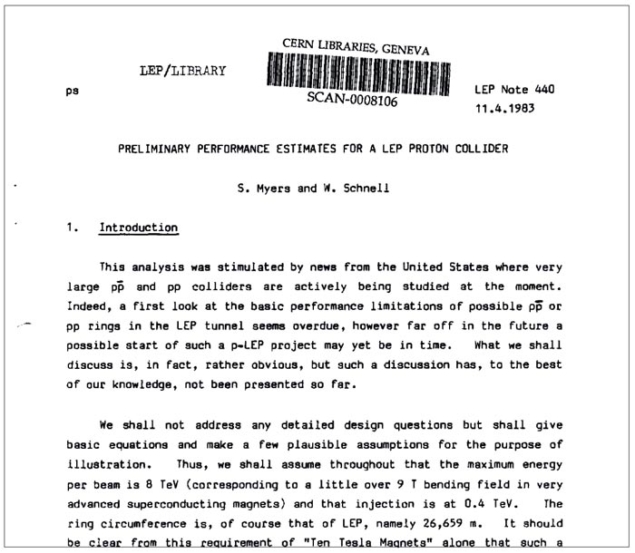As one of the first proponents for the LHC, Steve Myers has experienced the highs – and lows – that led to its superb performance 30 years later.

The origins of the LHC trace from the early 1980s, in the days when construction of the tunnel for the Large Electron–Positron (LEP) collider was just getting under way. In 1983, Steve Myers was given an unexpected opportunity to travel to the US and participate in discussions on future proton colliders. He recalls: “None of the more senior accelerator physicists was available, so I got the job.” This journey, it turned out, was to be the start of his long relationship with the LHC.
Myers appreciated the significance for CERN of the discussions in the US: “We knew this was going to be the future competition and I wanted to understand it extremely well.” So he readied himself thoroughly by studying everything on the subject that he could. “With the catalyst that I had to prepare myself for the meeting, I looked at all aspects of it,” he adds. After returning to CERN, he thought about the concept of a proton collider in the LEP tunnel and wrote up his calculations, together with Wolfgang Schnell. “Wolfgang and I had many discussions and then we had a very good paper,” he says.
The paper (LEP Note 440) provided estimates for the design of a proton collider in the LEP tunnel and was the first document to bring all of the ideas together. It raised many of the points that were subsequently part of the LHC design: 8 TeV beam energy, beam–beam limitation (arguing the case for a twin-ring accelerator), twin-bore magnets and the need for magnet development, problems with pile-up (multiple collisions per bunch-crossing) and impedance limitations.
After Myers’ initial investigations, the time was ripe to develop active interest in a future hadron collider at CERN
After Myers’ initial investigations, the time was ripe to develop active interest in a future hadron collider at CERN. A dedicated study group was established in late 1983 and the significant Lausanne workshop took place the following year, bringing experimental physicists together with accelerator experts to discuss the feasibility of the potential LHC. Then began the detailed preparation of the project design.
In the meantime in the US, the Superconducting Super Collider (SSC) project had been approved. Myers was on the accelerator physics subcommittee for both of the major US Department of Energy reviews of the SSC, in 1986 and 1990. He recalls that the committee recommended a number of essential improvements to the proposed design specification, which ultimately resulted in spiralling costs, contributing to the eventual cancellation of the project. “The project parameters got changed, the budget went up and they got scrapped in the end.”
The LHC design, being constrained by the size of the LEP tunnel, could not compete with the SSC in terms of energy. Strategically, however, the LHC proposal compensated for the energy difference between the machines by claiming a factor-10 higher luminosity – an argument that was pushed hard by Carlo Rubbia. “We went for 1034 and nobody thought we could do it, including ourselves! But we had to say it, otherwise we weren’t competitive,” Myers says, looking back. It now gives Myers enormous satisfaction to see that the LHC performance in the first run achieved a peak stable luminosity of 7.73 × 1033 cm–2 s–1, while running at low energy. He adds confidently: “We will do 1034 and much more.”
The decision to use a twin-ring construction for the LHC was of central importance because separate rings allow the number of bunches in the beam to be increased dramatically. To date, the LHC has been running with 1380 bunches and is designed to use twice that number. For comparison, Myers adds: “The best we ever did with LEP was 16 bunches. The ratio of the number of bunches is effectively the ratio of the luminosities.”
Design details

At CERN, it was difficult to make significant progress with the LHC design while manpower and resources were focused on running LEP. Things took off after the closure of LEP in 2000, when there was a major redeployment of staff onto the LHC project and detailed operational design of the machine got under way. The LHC team, led by Lyn Evans, had three departments headed by Philippe Lebrun (magnets, cryogenics and vacuum), Paulo Ciriani (infrastructure and technical services) and Myers (accelerator physics, beam diagnostics, controls, injection, extraction and beam dump, machine protection, radio frequency and power supplies).
Myers makes a typical understatement when asked about the challenges of managing a project of this size: “You do your planning on a regular basis.” This attitude provides the flexibility to exploit delays in the project in a positive way. “Every cloud has a silver lining,” he comments, illustrating his point with the stark image of thousands of magnets sitting in car parks around CERN. A delay that was caused by bad welds in the cryogenic system gave the magnet evaluation group the benefit of extra time to analyse individual magnet characteristics in detail. The magnets were then situated around the ring so that any higher-order field component in one is compensated by its neighbour, therefore minimizing nonlinear dynamic effects. Myers believes that is one of the reasons the machine has been so forgiving with the beam optics: “You spend millions getting the higher-order fields down, so you don’t have nonlinear motion and what was done by the magnet sorting gained us a significant factor on top of that.”
When asked about the key moments in his journey with the LHC, he is clear: “The big highlight for us is when the beam goes all of the way round both rings. Then you know you’re in business; you know you can do things.” To that end, he paid close attention to the potential showstoppers: “The polarities of thousands of magnets and power supplies had to be checked and we had to make sure there were no obstacles in the path of the beam.” During the phase of systematically evaluating the polarities, it turned out that only about half were right first time. There were systematic problems to correct and even differing wiring conventions to address. In addition, a design fault in more than 3000 plug-in modules meant that they did not expand correctly when the LHC was warmed up. This was a potential source of beam-path obstacles and was methodically fixed. These stories illustrate the high level of attention to detail that was necessary for the successful switch-on of the LHC on 10 September 2008.
The low point of Myers’ experience was, of course, the LHC accident on 19 September 2008, which occurred only a matter of hours after he was nominated director of accelerators and technology. The incident triggered a shutdown of more than a year for repairs and an exhaustive analysis of what had gone wrong. During this time, an unprecedented amount of effort was invested in improvements to quality assurance and machine protection. One of the most important consequences was the development of the state-of-the-art magnet protection system, which is more technically advanced than was possible at the time of the LHC design. The outcome is a machine that is extremely robust and whose behaviour is understood by the operations team.

In November 2009 the LHC was ready for testing once again. The first task was to ramp up the beam energy from the injection energy from the Super Proton Synchrotron of 0.45 TeV per beam. The process is complicated in the early stages by the behaviour of the superconducting magnets but the operations team succeeded in achieving 1.18 TeV per beam and established the LHC as the highest-energy collider ever built. By the end of March 2010, the first collisions at 7 TeV were made and from that point on the aim was to increase the collision rate by introducing more bunches with more protons per bunch and by squeezing the beam tighter at the interaction points. Every stage of this process was meticulously planned and carefully introduced, only going ahead when the machine protection team were completely satisfied.
In November 2009, when the LHC was ready to start up, both the machine and its experiments were thoroughly prepared for the physics programme ahead. The result was a spectacular level of productivity, leading to the series of announcements that culminated in the discovery of a Higgs boson. By the end of 2011 the LHC had surpassed its design luminosity for running with 3.5 TeV beams and the ATLAS and CMS experiments had seen the first hints of a new particle. The excitement was mounting and so was the pressure to generate as much data as possible. At the start of 2012, given that no magnet quenches had occurred while running with 3.5 TeV beams, it was considered safe to increase the beam energy to 4 TeV. With a collision rate of 20 MHz and levels of pile-up reaching 45, the experiments were successfully handling an almost overwhelming amount of data. Myers finds this an amazing achievement, as he says, “nobody thought we could handle the pile-up,” when the LHC was first proposed. He views the subsequent discovery announcement at CERN on 4 July 2012 as one of the most exciting moments of his career and, indeed, in the history of particle physics.
Reflecting on his journey with the LHC, Myers is keen to emphasize the importance of the people involved in its development, as well as the historical context in which it happened. In his early days at CERN in the 1970s, he was working with the Intersecting Storage Rings (ISR), which he calls “one of the best machines of its time”. As a result, “I knew protons extremely well,”he says. The experience he gained in those years has, in turn, contributed to his work on the LHC.
In the following years of building and operating LEP – as the world’s largest accelerator – many young engineers developed their expertise, just as Myers had on the ISR. “I think that’s why it worked so well,” he says, “because these guys came in as young graduates, not knowing anything about accelerators and we trained them all and they became the real experts, in the same way as I did on the ISR.” He sums up the value of this continuum of young people coming into CERN and becoming the next generation of experts: “That for me is what CERN is all about.”







